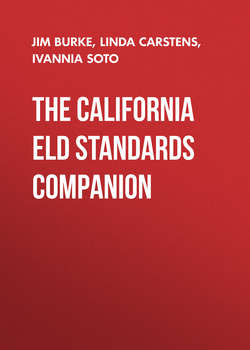Читать книгу The California ELD Standards Companion, Grades 3-5 - Jim Burke - Страница 22
На сайте Литреса книга снята с продажи.
Language Standards
Оглавление3 L.3.1: Demonstrate command of the conventions of standard English grammar and usage when writing or speaking.Explain the function of nouns, pronouns, verbs, adjectives, and adverbs in general and their functions in particular sentences.Form and use regular and irregular plural nouns.Use abstract nouns (e.g., childhood).Form and use regular and irregular verbs.Form and use the simple (e.g., I walked; I walk; I will walk) verb tenses.Ensure subject-verb and pronoun-antecedent agreement.Form and use comparative and superlative adjectives and adverbs, and choose between them depending on what is to be modified.Use coordinating and subordinating conjunctions.Produce simple, compound, and complex sentences.Write legibly in cursive or joined italics, allowing margins and correct spacing between letters in a word and words in a sentence.Use reciprocal pronouns correctly.
3 L.3.3: Use knowledge of language and its conventions when writing, speaking, reading, or listening.Choose words and phrases for effect.Recognize and observe differences between the conventions of spoken and written standard English.
3 L.3.6: Acquire and use accurately grade-appropriate conversational, general academic, and domain-specific words and phrases, including those that signal spatial and temporal relationships (e.g., After dinner that night we went looking for them).
4 L.4.1: Demonstrate command of the conventions of standard English grammar and usage when writing or speaking.Use interrogative, relative pronouns (who, whose, whom, which, that) and relative adverbs (where, when, why).Form and use the progressive (e.g., I was walking; I am walking; I will be walking) verb tenses.Use modal auxiliaries (e.g., can, may, must) to convey various conditions.Order adjectives within sentences according to conventional patterns (e.g., a small red bag rather than a red small bag).Form and use prepositional phrases.Produce complete sentences, recognizing and correcting inappropriate fragments and run-ons.Correctly use frequently confused words (e.g., to, too, two; there, their).Write fluidly and legibly in cursive or joined italics.
4 L.4.3: Use knowledge of language and its conventions when writing, speaking, reading, or listening.Choose words and phrases to convey ideas precisely.Choose punctuation for effect.Differentiate between contexts that call for formal English (e.g., presenting ideas) and situations where informal discourse is appropriate (e.g., small-group discussion).
4 L.4.6: Acquire and use accurately grade-appropriate general academic and domain-specific words and phrases, including those that signal precise actions, emotions, or states of being (e.g., quizzed, whined, stammered) an14d that are basic to a particular topic (e.g., wildlife, conservation, and endangered when discussing animal preservation).
5 L.5.1: Demonstrate command of the conventions of standard English grammar and usage when writing or speaking.Explain the function of conjunctions, prepositions, and interjections in general and their function in particular sentences.Form and use the perfect (e.g., I had walked; I have walked; I will have walked) verb tenses.Use verb tense to convey various times, sequences, states, and conditions.Recognize and correct inappropriate shifts in verb tense.Use correlative conjunctions (e.g., either/or, neither/nor).
5 L.5.3: Use knowledge of language and its conventions when writing, speaking, reading, or listening.Expand, combine, and reduce sentences for meaning, reader/listener interest, and style.Compare and contrast the varieties of English (e.g., dialects, registers) used in stories, dramas, or poems
5 L.5.6: Acquire and use accurately grade-appropriate general academic and domain-specific words and phrases, including those that signal contrast, addition, and other logical relationships (e.g., however, although, nevertheless, similarly, moreover, in addition).
Source: Common Core State Standards, K–12 English Language Arts (2010).
Notes
___________________________________________________________________________________
___________________________________________________________________________________
___________________________________________________________________________________
___________________________________________________________________________________
___________________________________________________________________________________
